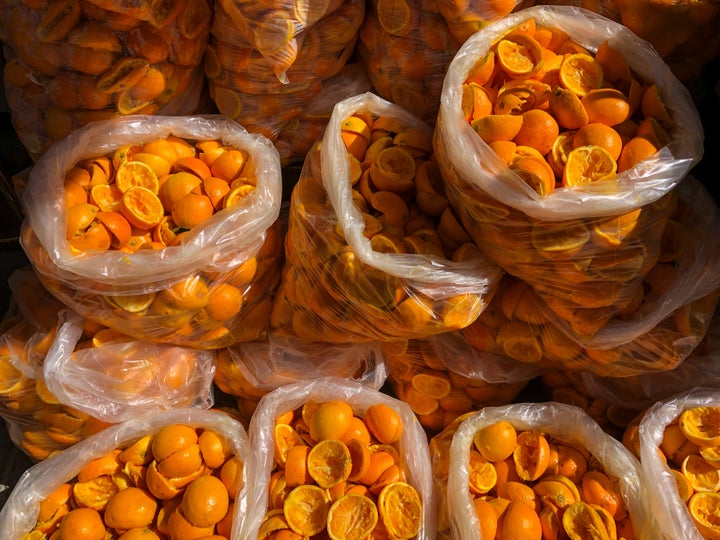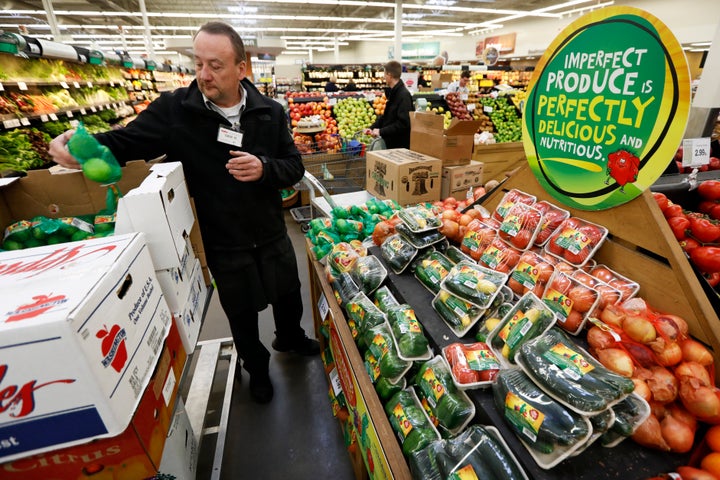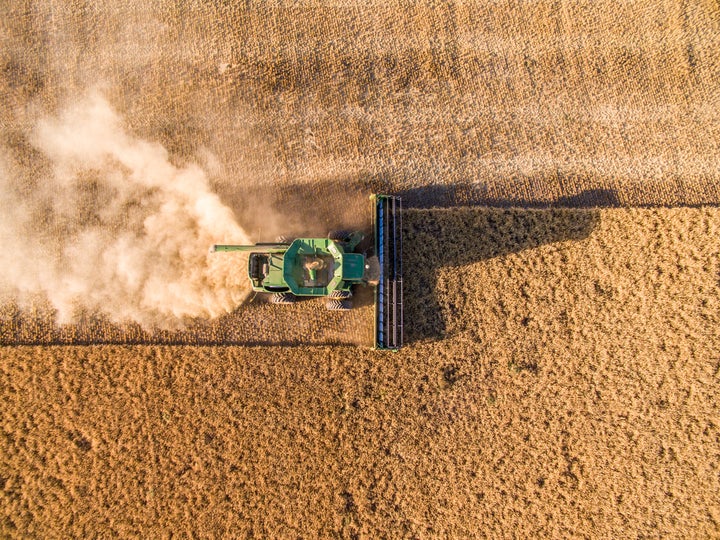Imagine a protein-packed snack made from leftover chicken bits. Tea made from avocado pits. Or seasoning your burger with extracts derived from mushroom stems instead of salt. It may sound funky, but it could be part of the future of food.
Societies around the world have always found innovative ways to make use of food waste. But only recently has it become a more mainstream idea for companies. Called “food upcycling,” it involves turning food waste from commercial processes that would otherwise end up in a landfill into new edible or biodegradable products ― from soups and juices to packaging and cosmetics.
“The vision,” said Turner Wyatt, co-founder and chief executive of food waste nonprofit Upcycled Food Association, “is that one day in the not too distant future, a consumer will walk into any given grocery store and be able to fill their whole cart with items that help reduce food waste.”
The food upcycling sector is small, but it’s growing. The sector was worth $46.7 billion last year and is expected to grow 5% each year over the next decade. Though most of this market is currently made up of companies turning food waste into animal feed, Wyatt says creating more upcycled food products for people can be a “powerful solution” to our food waste crisis.
The idea is that turning would-be waste into consumer products can help companies mitigate their climate and environmental impact. Roughly a third of all food produced in the world goes unconsumed, according to the United Nations. That’s 1.3 billion tons of food each year that could have been eaten ― the production of which releases 3.3 billion tons of climate-warming greenhouse gas emissions into our atmosphere. In the U.S. alone, 63 million tons of food (up to 40% of the country’s food) worth $218 billion is wasted every year.
This represents a huge drain on natural resources. “It’s outrageous,” said Ignacio Gavilan, director of environmental sustainability at the Consumer Goods Forum. About 70% of the freshwater withdrawals in the world go into agriculture, Gavilan said. “If we’re wasting one-third of the produce that gets harvested in the world, we’re wasting that water as well.”

According to the U.S. Environmental Protection Agency’s “food recovery hierarchy,” the most important way to reduce waste is to limit the amount generated in the first place. That means not buying or producing excess food, but it also means making new products from the waste created in the industrial food process, Wyatt said.
This requires finding opportunities throughout the supply chain ― for instance, “things like spent grain that’s left over after beer making, or all the pulp that’s left over after juice making,” he said. “You can’t show up to a food bank with a bunch of juice pulp.”
Perhaps the most popular and recognizable food waste campaigns are the “ugly food” initiatives.
Recovering misshapen, unwanted fruits and vegetables really took off with the public about a decade ago, and venture capital firms started backing startups promising to rescue food they say would otherwise be tossed, acting as a go-between for farmers, consumers and food banks.
Though the model has seen its share of criticism, these companies have managed to raise tens of millions of dollars and employ hundreds of people. And major retailers, including Kroger, Whole Foods and Walmart, now sell boxes of produce that isn’t perfect-looking enough to sell on the shelves. Since it launched in 2015, the major food subscription service Imperfect Foods claims that selling ugly food helped save 139 million pounds of food going to waste.

Then there are all the byproducts from production. New York-based condiment company Sir Kensington’s is using liquid from chickpeas that would have been tossed out during hummus production to make vegan mayonnaise. Chipotle is making clothing dye from avocado scraps. And leftover agave fibers from tequila production are being turned into bioplastics in a partnership between the makers of Jose Cuervo and the Ford Motor Co.
All told, upcycling excess or donated food into new products and putting “ugly” produce to use, along with freezing harvest surpluses so they don’t go bad, could prevent 368,000 tons of food going to waste each year in the U.S., according to the food waste nonprofit ReFED.
Last year, member companies of the Upcycled Food Association ― including pet food, coffee, juice and snack brands ― helped prevent about 8 million pounds of food waste, according to Wyatt.
But in order for upcycled food for humans to make any sort of dent, it’s crucial that companies scale up, said Toine Timmermans, coordinator of the Netherlands’ task force on a circular economy for food. To do that, they need to build up their customer base, which is challenging when you are selling items seen as waste and often at a higher price than traditional items.
A Dutch supermarket dedicated an aisle to surplus food items in 2018. Some sold well and the project was rolled out to a handful of other stores, but ultimately prices were too high to compete with regular items, and the idea was too niche for it to become a permanent aisle in a grocery store, explained Timmermans, who helped oversee the six-month pilot. Some brands moved their products online or targeted the food service industry rather than selling via retail chains.
In the same year, Tyson launched its “Yappah” protein crisp, made from a combination of its leftover chicken trim and leftover pulp and puree from Molson Coors beer production. But the product was shut down last year “for a variety of reasons, including overall viability,” a Tyson company spokesperson said. According to Food Dive, reviews were mixed, “with some customers lauding the concept and the taste, and others panning the packaging and the price.”

Timmermans argued that where these products and initiatives can have the biggest difference is in simply raising awareness among consumers about their effect on food waste more broadly. Whether this leads to consumers shopping more efficiently, demanding specific products or generally calling for more sustainable businesses, changing the public’s perspective can help “trigger” companies to more fully reexamine their supply chains.
“We overproduce in the western world,” said Timmermans, so it’s not just about finding ways to make something out of surplus after that waste is already produced. Instead, it should be about making sure we produce only what we need and effectively using everything we produce.
“For companies to truly tackle waste in their supply chain ― whether that’s during harvesting or by how it’s sold in the store ― the issue needs to be “top of mind” for CEOs and boards of directors, Gavilan said. Despite the business case being clear ― for every dollar invested in reducing food loss, $14 is saved in operational costs ― the “roadblock is companies not taking it seriously.”
Manufacturing accounts for 2% of all food lost in the U.S., and typically, companies analyze and disclose information only from their own operations. In order to successfully address this food waste, companies need to audit their whole supply chain to see where the biggest losses are occurring and where they can do better.
About 16% of food waste happens at the farm level, for instance. This is why in August, the Consumer Goods Forum launched a coalition of businesses and manufacturers to tackle food waste through disclosing food loss data along the supply chain and working with suppliers to improve efficiency at each step.
Stronger government incentives and regulations are also needed to push things forward. In the U.S., for instance, it’s still incredibly cheap to just send food to a landfill.
Ultimately, says Timmermans, it’s about shifting our mindset. From the very beginning of the production process, companies, farmers and manufacturers must think about how to utilize and sell all parts of their product; a “total use” model Timmermans calls it. “That’s part of the future of what we will see as a systemic solution for food waste reduction.”
HuffPost’s “Work in Progress” series focuses on the impact of business on society and the environment and is funded by Porticus. It is part of the “This New World” series. All content is editorially independent, with no influence or input from Porticus. If you have an idea or tip for the editorial series, send an email to thisnewworld@huffpost.com.